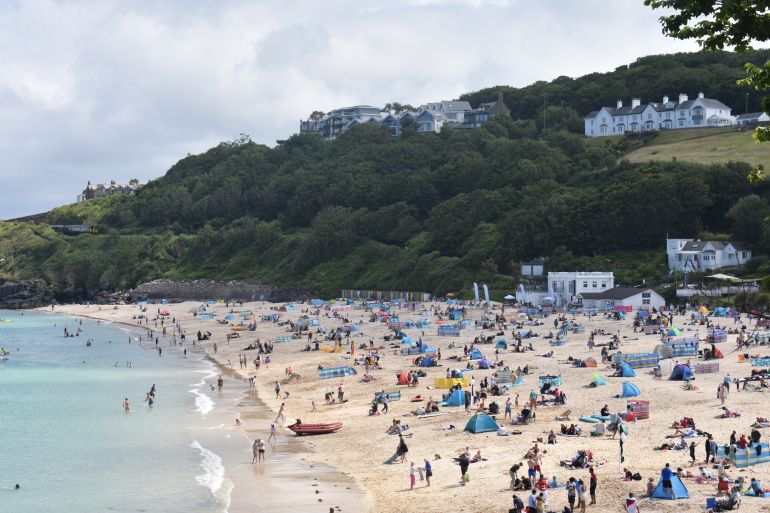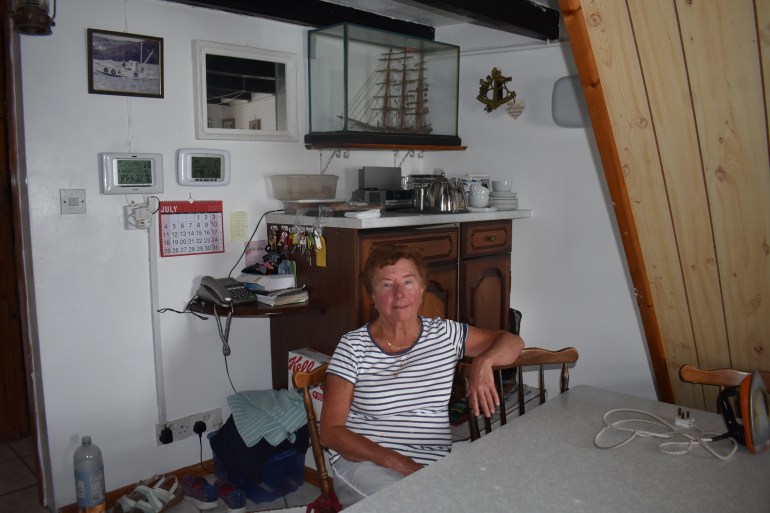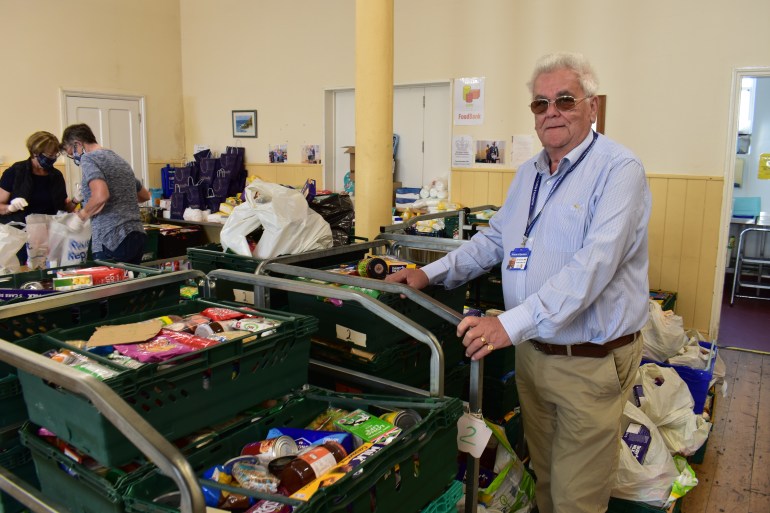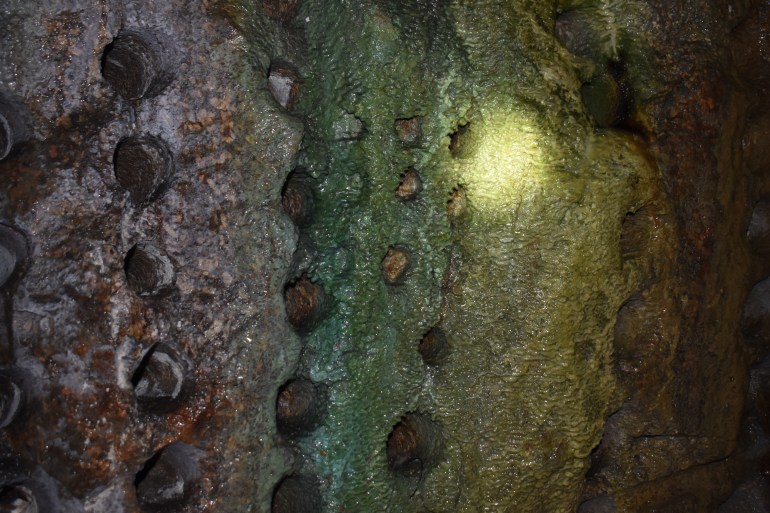A tale of two Cornwalls: Food banks amid luxury holiday lets
Tourists are drawn to the British county’s rugged cliffs and beautiful beaches, but locals face poverty and deprivation.

A remote corner of Britain is an unusual place for seven world leaders to congregate for a global conference. But Cornwall’s rugged cliffs and sprawling coastline proved a scenic stage for three days of political deliberations at this year’s G7 summit.
Cornwall – or Kernow to a traditional tongue – is Britain’s not-so-hidden gem. The country’s southwestern tip is beloved by both locals and tourists for its bounty of beaches, market towns and olde worlde culture.
Keep reading
list of 4 itemsDeath in a Glasgow hotel: The last years of Badreddin Bosh
The fruitless saga of the UK’s ‘Pick for Britain’ scheme
The long fight to criminalise rape in marriage
Visitors might liken the golden shores and crystal waters to the Caribbean – if only the sun shone more often. But, in early June, the weather did Britain a service. Picture-perfect images from Carbis Bay, the centre of the summit, captured politicians smiling on a podium in front of the Atlantic Ocean, enjoying Cornwall at its finest.

Boris Johnson’s G7 continued with a spectacular show. His high-profile guests dined on an outdoor barbeque of sparkling scallops and crab claws, and watched as nine aircraft shot across the sky, trailing plumes of red, white and blue.
Malcolm Bell, chief executive of Cornwall’s official tourist board, said the event was more than a political success. He believes the conference has put the region, which usually sees two million tourists each year, on the international map.
Traffic to the website “Visit Cornwall” surged after the G7, with the biggest spikes coming from outside the country. Curious browsers typing “Cornwall” into Google came from Japan (+820 percent), Mexico (+383 percent) and the US (+184 percent).
‘Silly season’
The tents have been dismantled and the security has dispersed, but you could be forgiven for thinking there is still an event under way in St Ives.
On a balmy Thursday in July, nearly a month after parts of the town closed for the G7, swarms of the tourists that swell its 12,000-strong population fill the streets. St Ives is teetering on peak season – as British schools are yet to break for summer – but the cobbled streets and narrow alleyways are already bursting at the seams.

A train pulls into the station and offloads a drove of visitors, sporting floppy hats, beach bats and cameras strung around their necks. Whether staying for a day or longer, they are restless to explore the charms of the coastal town.
They filter into the throng, funnelling into the meandering streets crammed with boutiques and cafés. Some head straight to the beach, to contend with lunch-thieving seagulls or wrestle with unruly windbreakers.
“Silly season” – as the locals know it – has officially begun.
Dawn Kugler, from Cardiff, Wales is a seasoned tourist. Her family has visited St Ives twice a year for the past 10 years. They book months in advance, to secure a spot in their favourite stretch of Cornwall.
But this year, her coastal retreat has been “rammed” with Britons who would usually holiday abroad. Due to the UK’s volatile traffic light system, which sets out international travel regulations based on coronavirus rates, many holidaymakers have swapped the shores of Europe for the Cornish Riviera.
Kugler, an associate director at a bank, has not had the relaxing retreat she imagined. “I don’t like crowds, but the first day we arrived, we went to a bar for a drink. It was carnage with the traffic coming through,” she says.
Gone are the days of deliberating over dinner menus, or popping into pubs for a quick pint. If restaurants aren’t booked prior to arrival, options are limited, if existent at all. “We’ve eaten quite a few takeaways or had dinner at 5pm. But it’s so packed everywhere you don’t want to go,” she adds.
Kugler says she was “lucky” to secure an Airbnb, which she booked during the Christmas lockdown when uptake was low. A five-night stay at the ‘Fisherman’s Cottage’, a whitewashed four-bed in the centre of town, cost her 1,100 pounds ($1,530).

But in the same week, a family from Yorkshire were not so fortunate. One regional newspaper reported that they were quoted an astonishing 71,000 pounds ($98,756) when they attempted to book a last-minute holiday in a “modest” three-bed for seven days in August.
The lure of beachside living – especially after periods cooped up during lockdown – has caused many to pack up and move to Cornwall for good.
Back in February, Cornwall replaced London as the most-searched-for place on property website Rightmove and it maintained its number one position in May. Rightmove’s property expert, Tim Bannister, said potential buyers coveted “a different lifestyle”.
However, he warned that those seeking to move would pay a premium for the county and due to the fast pace of sales, “only a lucky few” would get the chance to see it through.
A glance at Rightmove’s property listings in St Ives reveals plenty of characterful cottages, but noticeably, far fewer new builds. The reason for this is simple. Sensing their town was being overrun with outsiders, the population took stringent steps to crack down on second homes.
In May 2016, more than 80 percent of residents voted to reserve new homes for full-time residents, only granting planning permission for local housing.
Room with a view
Phyllis Rashleigh, 77, voted for the second house ban, but this did little to prevent the house adjoining hers from being sold to an out-of-towner.
It is hard to believe that the small semi-detached property, built from greyish, weathered granite could have just sold, unseen, for 900,000 pounds ($1,251,903). But it has joined the countless buildings in St Ives that have been snapped up for lucrative holiday lets.

The house is in a prime location – and in St Ives location is everything. Named “Penameyne”, which translates to “on top of the rocks” in Cornish, Rashleigh’s house sits above the harbour, straddling the sea wall.
Today, turquoise waves lap at the base of the property and the view from the balcony is calm. But in the winter, an easterly gale gets up, and spray pelts the house in a storm. “We have a saying down here,” says Rashleigh. “When you have a view, you have weather.”
It is a pearl of wisdom oft repeated since her late husband’s great-great-grandmother bought the house in 1876, for 86 pound 10 shillings. Passed down through generations of the Rashleigh family, it remains a fishing house at its core. At the doorway, visitors must stoop to enter, while inside long timber beams support low ceilings. Seascapes hang on the walls and relics of wooden ships sit in glass cases.
Rashleigh explains that the basement was once used for drying pilchards, which were packed into salt barrels while their oils drained out to sea. The reason the house is so close to the harbour wall was for convenience, so fish guts could be tossed out the backdoor.
Each occupant has left their mark on St Ives history – her husband’s ancestors as a harbour master and then birthing master, and her husband as a science teacher at the local school. But little remains of the town Rashleigh once knew.
She has watched as neighbours have moved or passed away, and as their houses have sold for eye-watering prices to strangers. Rashleigh says only 18 locals remain on the harbour front, and scoffs at the idea that there is still a “community”.
“We’ve lost that. We’re now nothing but a theme park. The fisherman would call it Center Parcs on sea,” she says. “All the people you see around aren’t from here. They’re here to see what we haven’t got any more.”

Rashleigh stays inside during busy periods, which this summer is most of the day. She does her shopping first thing in the morning, otherwise, she is unable to pull her trolley through the crowded streets. If she waits until afternoon food is “blitzed” from tourists buying beach picnics.
“We like to see people here. But years ago, they stayed in hotels, or in bed and breakfasts. The holiday trade in this town was built on the backs of fishermen’s wives letting their best bedroom to people who came down on holiday with their families. Now, we’ve got the big boys down, who made the rules so that all those people can’t operate any more. So they bought us out,” she says. “And we got nothing, just a dormitory.”
Locals in rural areas across the UK are increasingly directing their rage towards rental site Airbnb, which has given entrepreneurs and opportunists a chance to profit in tourist hotspots. Outsiders can buy a house as an investment opportunity, and rent it purely for holiday rentals.
There is a growing fear that second-homeowners can “play the system”. As a recent article in the Guardian explained, a “furnished holiday let” – which should be “available” for 210 days but needs to be let for only 105 – can register as a business ratepayer. The owner can then apply for 100 percent small business rates relief, in effect, cancelling their entire council tax bill.
In July, there were more than 1,000 properties listed in St Ives on Airbnb available for short-term lets. By comparison, there was just one long-term house to rent on Rightmove.
“They don’t give a toss about the town,” Rashleigh says. “They certainly don’t think that much about the locals apart from the fact that they’re giving them work. But it’s no good getting offered the work if they’ve got nowhere to live.”
Added to this is a growing concern that affordable housing is being bought to fuel the demand for second homes. In 2017, a man bought an ex-council house at auction in London for 1.44 million pounds ($2m). It was knocked down, and just four years later rebuilt as a luxury holiday let that will cost renters a small fortune of 7,000 pounds ($9,735) a week.
At the time, the association that sold the house, Devon and Cornwall Housing (DCH), justified the sale by saying proceeds will fund at least 10 more affordable houses.
But this still sits uneasily with some residents. “We’re not short of houses. We’re short of the will to make sure those houses are permanent houses for people who live there. Not people who just want to come and have a holiday and turn the key in the door and go home,” Rashleigh says.

After Rashleigh’s elderly neighbour moved out, the adjoining house was bought for holiday lets, bringing a stream of visitors to the newly renovated, nautical-themed bolthole. But in the winter, it is a different story. “All you see through the glazed doors is mail piled up. And filthy doors and dirty windows because nobody cleans anything any more. And it’s a slum,” Rashleigh adds.
Her wish is a double-edged sword. For the last two years, the holiday season has run later, leaving January and February the rare quiet months for residents to catch their breath.
Budgeting for winter
For other St Ives residents, winter offers little respite. Seasonal workers find that their one, two or three casual jobs can dry up after summer. Sands shift quickly in a “gig” economy, so workers must budget enough money to last them through the low season.
Young people are often hardest hit. Dolly Laity is from St Ives, though she now studies at a university in London. The 19-year-old is affable and approachable, perhaps due to years spent in customer service roles.
“I’ve worked in cleaning, I’ve worked in restaurants, I’ve worked in cafés. I’ve worked locally and in places further out like St Erth,” she says. “But in the winter, you can’t work. There’s no work. You’ve just got to hope that you make enough over the summer to last through the winter.”
This summer, she is pitching in on her father’s boats – one of which is named sentimentally after her – selling seal-spotting and lighthouse trips to tourists. Everyone knows “everyone’s business” in St Ives and though she says she “can’t breathe” without someone telling her father, she eventually wants to settle in the town where she was raised.

But Dolly also wants to be a graphic designer – two aspirations that are hard to reconcile. “My current job is better paid, but when I worked in restaurants I was on 4.50 pounds ($6.26) an hour,” she says. “The job opportunities here aren’t spectacular if you don’t want to work in a restaurant or a boat.”
“On the one hand, this business survives off tourism, so tourists are paying my bills. But on the other hand, you get houses down here that are going for millions and no one can afford to buy a house. The rent down here is the same as London in a lot of cases.”
“I don’t think I’ll ever be able to afford a house down here until I’ve got money,” she adds.
The Richest Square Mile of the World
About 21km (13 miles) away from the hustle and bustle of St Ives, there is barely a tourist in sight. Yet escalating house prices and job insecurity have already left their mark on the landlocked Camborne corridor.

Rural poverty is well-documented in the towns of Redruth, Camborne and Pool. Reports have suggested that this part of the county is the second-most deprived region in Northern Europe and that, because of this poverty, before the UK’s departure from the European Union, Cornwall received more EU funding than any other area of the country.
A long time has passed since the region was Europe’s mining capital. In the 1870s, there was so much tin and copper in the ground it was named ‘the richest square mile in the world’. Engine houses and chimneys still poke out of fields and towns, though ivy crawls around the crumbling bricks. The old machinery is now incongruous, an heirloom of a bygone era.
A rise in competition from abroad led Cornwall’s 4,000-year-old coal mining industry to collapse. Mines went dark throughout the 20th century, and unlike coastal towns, Camborne could not sell its picturesque scenery. Without tourism to prop up the economy, Camborne is a stark reminder of the deprivation that afflicts pockets of the county.

In contrast to St Ives, Camborne on a weekday afternoon is like a ghost town, with empty streets and shops boarded-up, their paint peeling. There are job centres, housing estates, and more than a dozen charity shops, and in the heart of Camborne, a muted pink church, where some of the town’s problems are brought to the fore.
Three days a week the building doubles as a food bank, established by local Donovan Gardner with his late wife, Jennifer. The 76-year-old set up Transformation CPR food bank at a time of “pure emergency” to respond to the 2008 financial crash. “I volunteered for two years, and here I am 12 years down the road still going,” he says.
For Gardner, the scale of deprivation on his doorstep was too hard to ignore. Every week, he oversees the distribution of approximately 23,000 meals to more than 540 families – though it is fabled that he is due to retire this year.
Gardner is joking and jovial, despite the weight of his task. Perhaps this is how he deals with the “real crisis problems” he encounters. “I had a lady that hadn’t eaten for a week, and her child was only on beans on toast because their benefits hadn’t come through for weeks,” he says.

His mission is to address the inequalities facing residents, especially after Cornwall saw the largest rise in child poverty last year in the southwest of England. “There are children in this town, three miles (4.8km) from the sea, who have never seen the sea,” he adds.
Thirty minutes before the church’s doors open, half a dozen volunteers dash around sorting boxes stacked with food and essential products. Alongside tinned goods are fresh Cornish pasties and tubs of ice cream donated by local businesses.
Today, there are also 4,500 frozen hakes left over from the G7 conference. “I wrote to Boris Johnson, and said, ‘If you really want to see Cornwall at its worst rather than at its best then come and visit us,’” Gardner says. “But he never answered me, he didn’t come.”
Gardner has lived through unemployment as a worker at Holmans, a mining and equipment manufacturer in Camborne. The company was a bedrock for the town – employing 3,000 people in its heyday. But, in the 1960s, it closed and the once prospering factory was demolished and replaced by a supermarket car park.

“It was a good industrial centre, a gateway to hundreds of jobs. When it died so did the jobs, people obviously moved out of here,” he says.
Underneath the veil
One woman queueing to get food is a single mother, who was born in Cornwall and has returned recently with her two children. She wishes to remain anonymous, as she had left her former home abruptly, in order to escape her ex-partner.
Compared with others at the food bank, she has a good job at a local company. “You see food banks but never thought you’d be in the situation to rely on one,” she says. But after her young child came into contact with a pupil with COVID-19 at school, the whole family was forced to isolate. She was not paid for the time she could not work. With food expenses mounting and no free-school meals for the children, she turned to the food bank for support.
This week, her family won’t go hungry, although they still have the “ridiculous” problem of social housing to contend with. “There’s so little funding for anything because everyone just looks at Cornwall as a nice holiday destination. But there’s a cost to it as well,” she says.

The mother-of-two has been on the HomeChoice list for years, which in theory allows residents to find affordable houses in the area. However, houses are snapped up in days. She complains that she applied to one recently and was 193 in a queue of 280 applicants. “You’ve got no hope. But if my landlord throws me out, we’ll be either in a tent or in a bed and breakfast somewhere probably miles away from their school,” she says.
Emma Lankford, a caseworker at charity Cornwall Neighbourhoods for Change, said the affordable housing shortage was already having a “domino effect” across the county.
“Social housing and homelessness is already on the rise,” she says. According to Cornwall Council it can cost up to 20,000 pounds ($27,836) a year to put a family with children in temporary accommodation. “This is not economically viable,” Lankford adds.
In her role as a crisis worker, she has seen a massive spike in domestic violence and suicide rates this year. Mental health, she says, will ultimately be “a bigger killer” in the county than COVID. But with an increasing population and only one major hospital in Cornwall, Treliske, she fears services will buckle under the strain.
“I don’t think it’s down to greed, I think it’s lack of knowledge,” Lankford says. “[With] people not being able to move abroad or travel at the moment, Cornwall may look like a great hotspot right now. But if people really knew what was beneath the veil it might make them think twice.”
A boost for Cornish pride
A short way outside Camborne, in a village called Troon, a test mine has reopened for research and development purposes. The price and demand of tin and copper has risen, enough to stir up excitement that drilling for mineral ores is viable.

Former miner-turned-councillor, Mark Kaczmarek, 60, is working onsite at the project. His father may have come from Poland but he has a broad West Country accent and is quick to correct an outsider’s vernacular. In his office, he clicks the kettle to boil and offers a generous slice of saffron cake – that is as long as it is pronounced the Cornish way; saff-run, not saff-ron.
Kaczmarek worked alongside his father at South Crofty, the last operating tin mine in the county. In 1998, he watched with disbelief as the fortress of mining and coal in Europe “fell like the Alamo”. The ramifications for Cornish industry and pride, he says, were “soul-destroying”.
As the mine’s trade union representative, Kaczmarek fought hard to keep the industry alive. “I did the battles with the government,” he says. “It was high profile and it was hard. You’re not just losing mates, you’re losing family members. We saw [them] more than we did your own family.”
Although lobbying the government was fruitless, Kaczmarek was inspired to stand as an independent councillor. For more than eight years, he was a cabinet member, where he pushed to promote skilled, stable industries such as mining.
His faith in the old trade lies in “the camaraderie” and the ability to “earn real money”. Mining is in Cornwall’s blood – emblazoned into the colours of its flag, in the white tin flowing from the black rock. A revival, he hopes, would restore pride in the community.
“The trouble with Cornwall is the government promoted it for holidays and tourism,” Kaczmarek says. “What we need is employment here that will pay a mortgage, or that will pay rent, which is quite often higher than what a mortgage would be. The hospitality trade is up and down and the hours are all over the place. You need good levels of permanent employment.”
However, he is careful not to gloss over the gruelling reality of mining. He reflects on the deafening blasts and pungent fumes, and the need to suck oranges throughout the day, just to rinse the oil from his palette.

Nevertheless, there is a sparkle in his eyes when he gives a tour of the test mine in Troon. The tunnels are dark and dank, and the occasional bat swoops overhead. But this mine is only 20 metres deep – thankfully, it is possible to walk in and out.
Kaczmarek hopes larger businesses will begin to invest in the county. There is optimism that Cornwall could be a trailblazer in renewable energy, with an exploratory drilling operation already proposed for his old stomping ground, South Crofty. In July, the price of tin to be delivered in three months rocketed on the London Metal Exchange to $35,000 a tonne.
Every so often, he flicks his head torch towards the wall, illuminating copper, emerald and crimson streaks which glisten on the grey rock. Mineral deposits, or the glitter maybe, of riches.

At its end, the mine opens out into tranquil countryside high on a hill. Panoramic views capture the rolling fields – where the sprawl of second homes and holiday houses have not yet reached. Kaczmarek points in the distance, near a herd of grazing cows, to a site that was used for the G7 summit only a short time ago.
“For too long, we put all our eggs in one basket with tourism, and then we saw with COVID and the lockdown how much it was impacted. But there’s a saturation point,” Kaczmarek says.
“We do surveys on housing needs in Cornwall, but every time someone sees a new glamping area or camping pod, there’s no survey on do we need any more tourists?”